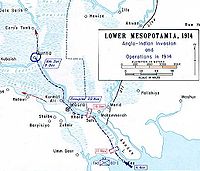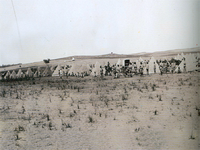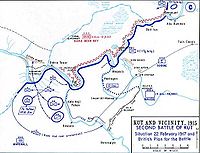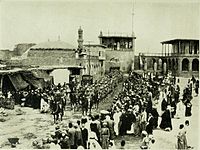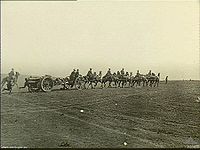- Mesopotamian campaign
-
Mesopotamian campaign Part of Middle Eastern theatre (World War I) 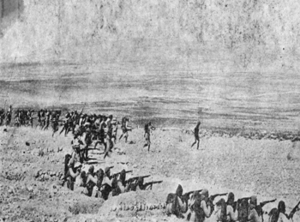
The trenches at the Siege of Kut.Date November 1914 - 14 November 1918 Location Iraq (Mesopotamia) Result British victory, Treaty of Sèvres. Territorial
changesPartitioning of the Ottoman Empire Belligerents  British Empire
British Empire
 Ottoman Empire
Ottoman Empire
 German Empire
German EmpireCommanders and leaders  General Nixon
General Nixon
 General Lake
General Lake
 General Maude
General Maude Süleyman Askerî Bey
Süleyman Askerî Bey
 Colmar Freiherr von der Goltz
Colmar Freiherr von der Goltz
 Nureddin Bey
Nureddin Bey
 Khalil Pasha
Khalil Pasha
 Kâzım Karabekir
Kâzım Karabekir
 Ali İhsan Pasha
Ali İhsan PashaStrength 112,000 100,000+ ? Casualties and losses 92,000 100,000 ? Mesopotamian campaign- Fao Landing
- Basra
- Qurna
- Shaiba
- Es Sinn
- Ctesiphon
- Umm-at-Tubal
- 1st Kut
- Shiekh Sa'ad
- Wadi
- Hanna
- Dujaila
- 2nd Kut
- Baghdad
- Samarrah Offensive
- Jebel Hamlin
- Istabulat
- Ramadi
- Khan Baghdadi
- Sharqat
Theatres of World War I- Caucasus
- Persia
- Gallipoli
- Mesopotamia
- Sinai and Palestine
- South Arabia
- South-West Africa
- West Africa
- East Africa
- North Africa
Other theatres:
- America
- Atlantic Ocean
- Mediterranean
The Mesopotamian campaign was a campaign in the Middle Eastern theatre of World War I fought between the Allies represented by the British Empire, mostly troops from the Indian Empire, and the Central Powers, mostly of the Ottoman Empire.
Contents
Background
The Ottoman Empire had conquered the region in the early 16th century, however never fully gained complete control over the area. Regional pockets of Ottoman control through local proxy rulers maintained the Ottoman's reach throughout Mesopotamia. With the turn of the 19th century came reforms. Work began on a Baghdad Railway in 1888: by 1915 it had only four gaps, and travel time from Istanbul to Baghdad had fallen to 21 days.
The Anglo-Persian Oil Company had exclusive rights to petroleum deposits throughout the Persian Empire except in the provinces of Azerbaijan, Ghilan, Mazendaran, Asdrabad, and Khorasan.[1] In 1914, before the war, the British government had contracted with the company for oil for the navy.[1] Kuwait was another strategic factor for the British.
The Ottoman Empire did not expect any major action in this region.
The operational area of the Mesopotamian campaign was limited to the lands watered by the rivers Euphrates and Tigris. The main challenge was moving the supplies and troops through the swamps and deserts which surrounded the area of conflict.
Shortly after the European war started, the British sent a military force to protect Abadan. In Abadan was one of the world's earliest oil refineries. British operational planning included landing troops in the Shatt-al-Arab. The reinforced Indian 6th (Poona) Infantry Division from the British Indian Army was assigned, designated as Indian Expeditionary Force D (IEFD).
The Ottoman Fourth Army was located in the region. The army was composed of two corps, the XII Corps (Ottoman Empire) with 35th and 36th Divisions at Mosul and XIII Corps (Ottoman Empire) with the 37th and 38th Divisions at Baghdad.
On 29 October 1914, after the Pursuit of Goeben and Breslau, Breslau bombarded the Black Sea port of Theodosia. On 30 October the High Command in Istanbul changed the force distribution. On 2 November Grand Vizier Said Halim Pasha expressed regret to the Allies for the operations of the navy. Russian Minister of Foreign Affairs Sergey Sazonov said it was too late and Russia considered this raid as an act of war. The Cabinet tried to explain that hostilities were begun without its sanction by German officers serving in the navy. The Allies insisted on reparations to Russia, the dismissal of German officers from the Goeben and Breslau, and the internment of the German ships until the end of the war. But before the Ottoman government responded Great Britain and France declared war on the Ottoman Empire on 5 November. CUP's official Declaration of War came on 14 November.[2]
When the Caucasus Campaign became a reality with the Bergmann Offensive, Enver Pasha sent the 37th Division and the XIII Corps Headquarters to the Caucasus in support of the Third Army. The entire XII Corps was deployed to the Sinai and Palestine Campaign. The Fourth Army Headquarters was sent to Syria, to replace the Second Army Headquarters which went to Istanbul. In place of the Fourth Army was "Iraq Area Command" with only the 38th Division under its command.[3]
Mesopotamia was a low priority area for the Ottomans. Regiments of the XII and XIII Corps were maintained at low levels in peacetime. Lieutenant Colonel Süleyman Askerî Bey became the commander. He redeployed portions of the 38th Division at the mouth of Shatt-al-Arab. The rest of the defensive force was stationed in Basra. The Ottoman General Staff did not even possess a proper map of Mesopotamia. They tried to draw a map with the help of some people who used to work in Iraq before the war, although this attempt failed. Enver Pasha bought two German maps scaled 1/1,500,000.
Operations
1914
On 6 November 1914, the British offensive began with the naval force bombarding the old fort at Fao, which was located at the point where the Shatt-al-Arab meets the Persian Gulf. At the Fao Landing, the British Indian Expeditionary Force D (IEF D), comprising the 6th (Poona) Division led by Lieutenant General Arthur Barrett with Sir Percy Cox as Political Officer, was opposed by 350 Ottoman troops and 4 cannons. By mid-November, the Poona Division was fully ashore and moved towards the city of Basra.
On 22 November, the British occupied the city of Basra against a force of Ottoman soldiers of the Iraq Area Command commanded by Suphi Bey, the Governor of Basra. The Ottoman troops ran after a short fight, abandoning Basra and retreated farther up the river. The British occupied Basra and established order in the town. The British then continued their advance, and at the Battle of Qurna they succeeded in capturing Subhi Bey and 1,000 of his Ottoman troops. That gave the British a very strong position and ensured that Basra and the oilfields would be protected from an Ottoman advance. The main Ottoman army, under the overall command of Khalil Pasha was located 275 miles north-west around Baghdad. They made only weak efforts to dislodge the British.
1915
- Operations of 1915
On 2 January, Süleyman Askerî Bey assumed the Iraq Area Command. The Ottoman Army did not have any other resources at the time to move to this region because other areas such as Gallipoli, the Caucasus, and Palestine had higher priority. Süleyman Askerî Bey sent letters to Arab sheiks in an attempt to organize them to fight against the British. He wanted to retake the Shatt-al-Arab region at any cost.
On 12 April, Süleyman Askerî attacked the British camp at Shaiba in what became known as the Battle of Shaiba. He had about 4,000 regular troops and about 14,000 Arab irregulars. The attack started early in the morning. These forces provided by Arab sheiks did not produce results. However, the Ottoman infantry launched a series of relentless attacks on the fortified British camp and later attempted by bypass it. When the British cavalry and infantry counter attacked Suleyman Askari pulled his troops back. The next day the British attacked his defensive positions. It was a hard fought infantry battle in which the British infantry overcame tough Ottoman opposition. Ottoman losses numbered 2400 men killed, wounded, or taken prisoner as well as two artillery field pieces lost.[4] The retreat ended 75 miles up the river at Hamisiye. Süleyman Askerî was wounded at Shaiba. Disappointed and depressed, he shot himself at the hospital in Baghdad[5] In his place Colonel Nureddin was appointed commander of the Iraq Area Command on 20 April 1915. Nureddin was one of the few officers to reach high command without the benefit of a staff college education. He did, however, have extensive combat experience.[6]
Due to the unexpected success British command reconsidered their plan and General Sir John Nixon was sent in April 1915 to take command. He ordered Charles Vere Ferrers Townshend to advance to Kut or even to Baghdad if possible.[7] Townshend and his small army advanced up the Tigris river. They defeated several Ottoman forces sent to halt him. Logistically, his advance was very difficult to sustain, but it was sustained.
Enver Pasha worried about the possible fall of Baghdad. He realized the mistake of underestimating the importance of the Mesopotamian campaign. He ordered the 35th Division and Mehmet Fazıl Pasha to return to their old location, which was Mosul. The 38th Division was reconstituted. The Sixth Army was created on 5 October 1915, and its commander was a 76 year old German General Colmar von der Goltz. Von der Goltz was a famous military historian who had written several classic books on military operations. He had also spent many years working as a military adviser in the Ottoman Empire. However, he was in Thrace commanding the Ottoman First Army and would not reach the theater for some time. Colonel Nureddin the former commander of the Iraq Area Command was still in charge on the ground.[6]
On 22 November, Townshend and Nureddin fought a battle at Ctesiphon, a town 25 miles south of Baghdad. The conflict lasted five days. The battle was a stalemate as both the Ottomans and the British ended up retreating from the battlefield. Townshend concluded that a full scale retreat was necessary. However, Nureddin realized the British were retreating and cancelled his retreat, then followed the British.[8] Townshend withdrew his division in good order back to Kut-al-Amara. He halted and fortified the position. Nureddin pursued with his forces. He tried to encircle the British with his XVIII Corps composed of the 45th Division, 51st Division and 2nd Tribal Cavalry Brigade.[9] The exhausted and depleted British force was urged back to the defenses of Kut-al-Amara. The retreat finalized on 3 December. Nureddin encircled the British at Kut-al-Amara, and sent other forces down river to prevent the British from marching to the relief of the garrison.
On 7 December, the siege of Kut began. From the Ottoman perspective; Siege of Kut prevented Sixth Army to perform other operations. From the British perspective, defending Kut as opposed to retreating back to Basra was a mistake since Kut was isolated. It could be defended, but it could not be resupplied. Von der Goltz helped the Ottoman forces build defensive positions around Kut. The Sixth Army was reorganized into 2 corps, the XIII and the XVIII. Nureddin Pasha gave command to Von der Goltz. With the reorganization the Sixth Army laid siege to the British. New fortified positions established down river fended off any attempt to rescue Townshend. Townshend suggested an attempt to break out but this was initially rejected by Sir John Nixon, however he relented. Nixon under the command of General Aylmer established a relief force. General Aylmer made three major attempts to break the siege, but each effort was unsuccessful.
1916
On 20 January, Enver Pasha replaced Nureddin Pasha with Colonel Halil Kut (Khalil Pasha). Nureddin Pasha did not want to work with a German General. He send a telegram to War ministry "The Iraq Army has already proven that it does not need the military knowledge of Goltz Pasha…" After the first failure, General Nixon was replaced by General Lake. British forces received small quantities of supplies from the air. These drops were not enough to feed the garrison, though. Halil Kut forced the British to choose between starving or surrendering, though in the mean time they would try to lift the siege.
Between January–March 1916, both Townshend and Aylmer launched several attacks in an attempt to lift the siege. In sequence, the attacks took place at the Battle of Sheikh Sa'ad, the Battle of the Wadi, the Battle of Hanna, and the Battle of Dujaila Redoubt. These series of British attempts to break through the encirclement did not succeed and their costs were heavy. Both sides suffered high casualties. In February, XIII Corps received 2nd Infantry Division as a reinforcement. Food and hopes were running out for Townshend in Kut-al-Amara. Disease were spreading rapidly and could not be cured.
On 19 April Field Marshal Von der Goltz died of cholera. On 24 April, an attempt by the paddle steamer “Julnar” to re-supply the town by river failed. With that there was no way the British could resupply Kut. After repeated attempts to break through the Ottoman attacks on the city rather than wait for reinforcements Townshend surrendered on 29 April 1916. The remaining force in Kut-al-Amara of 13,164 soldiers became captives of the Ottomans [10] .
The British viewed the loss of Kut as a humiliating defeat. It had been many years since such a large body of British Army soldiers had surrendered to an enemy. Also this loss followed only four months after the British defeat at the Battle of Gallipoli. Nearly all the British commanders involved in the failure to rescue Townshend were removed from command. The Ottomans proved they were good at holding defensive positions against superior forces.
A major problem for the British was the lack of logistical infrastructure. When ships arrived at Basra, they had to be unloaded by small boats which then unloaded their cargo which was then stored in warehouses, which there were not enough of in Basra. Ships often sat for days waiting to be unloaded. Then supplies had to be sent north along the river in shallow draft river steamers because there were almost no roads north. Usually the amount of supplies being sent north was barely adequate to supply the forces in place. A plan to build a railway was rejected by the Indian Government in 1915, but after Kut it was approved.[11] After the defeat at Kut, the British made a major effort to improve the ability to move men and equipment into theater, and keep them supplied. The port at Basra was greatly improved so that ships could be quickly unloaded.[12] Good roads were built around Basra. Rest camps and supply dumps were created to receive men and material from the port. More and better river steamers were put into service moving supplies up river.[13] New hospitals were also set up to better care for the sick and wounded. As a result, the British were able to bring more troops and equipment to the front lines and keep them properly supplied for a new offensive.
1917
The British refused to let this defeat stand and so the new commander, General Maude was given additional reinforcements and equipment. For the next six months he trained and organized his army. At the same time, the Ottoman Sixth Army was growing weaker. Khalil Pasha received very few replacements, and ended up disbanding the weak 38th Division and used its soldiers as replacements for his other divisions, the 46th, 51st, 35th, and 52nd.[14]
Maude's offensive was launched on 13 December 1916. The British advanced up both sides of the Tigris river, forcing the Ottoman army out of a number of fortified positions along the way. General Maude's offensive was methodical, organized, and successful. Khalil Pasha was able to concentrate most of his forces against Maude near Kut. However, Maude switched his advance to the other bank of the Tigris, bypassing most of the Ottoman forces. The Ottoman XVIII Corps escaped destruction only by fighting some desperate rear guard actions. It did lose quite a bit of equipment and supplies.[15] The British occupied Kut and continued to advance up the Tigris.
By early March, the British were at the outskirts of Baghdad, and the Baghdad garrison, under the direct command of the Governor of Baghdad province Halil Kut (Khalil Pasha), tried to stop them on the Diyala river. General Maude outmanoeuvered the Ottoman forces, destroyed an Ottoman regiment and captured the Ottoman defensive positions. Khalil Pasha retreated in disarray out of the city. On 11 March 1917 the British entered Baghdad where they were greeted as liberators. The British Indian Army played a significant role in the liberation of Baghdad. Amidst the confusion of the retreat a large part of the Ottoman army (some 15,000 soldiers) were captured. A week after the city fell, General Maude issued the oft-quoted Proclamation of Baghdad, which contained the famous line "our armies do not come into your cities and lands as conquerors or enemies, but as liberators".
Khalil Pasha withdrew his battered Sixth Army up river and established his headquarters in Mosul. He had about 30,000 total troops with which to oppose Maude. In April, he received the 2nd Infantry Division, but overall the Ottoman strategic position was bad in the spring of 1917.[16] After the capture of Baghdad, Maude stopped his advance. He felt his supply lines were too long, conditions in the summer made campaigning difficult and he had been denied reinforcements he felt he needed.[16]
General Maude died of cholera on 18 November. He was replaced by General William Marshall who halted operations for the winter.
1918
The British resumed their offensive in late February 1918 capturing Hīt and Khan al Baghdadi in March, and Kifri in April. For the rest of the 1918, the British had to move troops to the Sinai and Palestine Campaign in support of the Battle of Megiddo. General Marshall moved some of the forces east in support of General Lionel Dunsterville's operations in Persia during the summer of 1918. His very powerful army was "astonishingly inactive, not only in the hot season but through most of the cold".[17] The fight in Mesopotamia was not wanted anymore.
Armistice conditions between the Allies and the Ottoman Empire began negotiations with the turn of October. General Marshall, following instructions from the War Office that "every effort was to be made to score as heavily as possible on the Tigris before the whistle blew[18]" went on the offensive for the last time. General Alexander Cobbe commanded a British force from Baghdad on 23 October 1918. Within two days it covered 120 kilometers, reaching the Little Zab River, where it expected to meet and engage the Ottoman Sixth Army operating under Ismail Hakki Bey. He fought a battle at the Battle of Sharqat, capturing nearly the entire Ottoman force.
Armistice of Mudros, October
On 30 October 1918, the Armistice of Mudros was signed and both parties accepted their current positions. General Marshall accepted the surrender of Khalil Pasha and the Ottoman 6th Army at the same day. But Cobbe did not hold his current position as the armistice required, and continued to advance on Mosul in the face of Turkish protests.[18] British troops marched unopposed into Mosul on the 14 November 1918. The ownership of the Mosul Province and its rich oil fields became an international issue.
The war in Mesopotamia was over on 14 November 1918. It was 15 days after the Armistice and one day after the occupation of Istanbul.
- Commanders
-
Miralay Nureddin Bey
-
Mirliva Khalil Pasha
-
Miralay Kâzım Bey
-
Müşir Goltz Pasha
Aftermath
See also: Partitioning of the Ottoman EmpireWith British Indian forces already on the ground, the British imported civil servants from India who had previous knowledge and experience on how the government of a colony is supposed to run. The expulsion of Ottomans from the region shook the centuries old power balance. Arabs who believed that the expulsion of the Ottomans would lead to greater independence and fought against the Ottoman forces along the Allies faced another dilemma. They were disappointed with the arguments regarding the establishment of British Mandate of Mesopotamia.
Three important anticolonial secret societies had been formed in the region during 1918 and 1919. At Najaf, Jamiyat an Nahda al Islamiya (The League of the Islamic Awakening) was organized. Al Jamiya al Wataniya al Islamiya (The Muslim National League) was formed with the object of organizing and mobilizing the population for major resistance. In February 1919, in Baghdad, a coalition of Shia merchants, Sunni teachers and civil servants, Sunni and Shia ulama, and Iraqi officers formed the Haras al Istiqlal (the Guardians of Independence). The Istiqlal had member groups in Karbala, Najaf, Kut, and Hillah. The British were in a precarious situation with the Issue of Mosul. They were adopting almost desperate measures to protect their interests. The Iraqi revolt against the British developed just after they declared their authority. It was put down by the RAF Iraq Command during the summer of 1920.
The Ottoman parliament mostly accepted the cession of the region, but they had a different view on the issue of Mosul. They declared the Misak-ı Milli. Misak-ı Milli stated that the Mosul Province was a part of their heartland, based on a common past, history, concept of morals and laws. Presumably, from a British perspective, if Mustafa Kemal Atatürk succeeded in securing the stability in his efforts to establish Republic of Turkey, he would have turned his attention to recovering Mosul and penetrate into Mesopotamia, where the native population would probably join him. The British Foreign Secretary attempted to disclaim any existence of oil in the Mosul area. On 23 January 1923, Lord Curzon argued that the existence of oil was no more than hypothetical.[18] However, according to Armstrong, "England wanted oil. Mosul and Kurds were the key."[19]
Casualties
The British and the British Indian Army forces lost 92,000 soldiers in the Mesopotamian campaign. Ottoman losses are unknown but the British captured a total of 45,000 prisoners of war. By the end of 1918 the British had deployed 410,000 men into the area though only 112,000 of them were combat troops. The vast majority of the British empire forces in this campaign were recruited from India.
Bibliography
- F.J.Moberley The Campaign in Mesopotamia(4 vols, 1923–27, HMSO, official history)
- A. J. Barker (1967) The Neglected War. Faber and Faber.
- A. J. Barker (2009) The First Iraq War, 1914-1918: Britain's Mesopotamian Campaign. New York: Enigma Books. ISBN 978-1-929631-86-5. (published in 1967 in Britain as The Neglected War)
- Mesopotamia Campaign - from The Long, Long Trail website, downloaded January, 2006.
- [1] - Mesopotamia Campaign, from The Commonwealth War Graves Commission newsletter, downloaded June, 2011.
- Strachan, Hew (2003). The First World War, pp 123–125. Viking (Published by the Penguin Group)
- Fromkin, David (1989). A Peace to End All Peace. Avon Books.
- U.S. Military Academy map of the 1915 Campaign
- U.S. Military Academy map of the Siege of Kut
- Esposito, Vincent (ed.) (1959). The West Point Atlas of American Wars - Vol. 2; map 53. Frederick Praeger Press.
- Briton Cooper Busch (1971) Britain, India, and the Arabs 1914-1921. University of California Press.
- Wilcox, Ron (2006) Battles on the Tigris. Pen and Sword Military
- Cato, Conrad. The Navy in Mesopotamia, 1914-1917. London: Constable & Co., 1917.
- E.O.Mousley The Secrets of a Kuttite: An Authentic Story of Kut, Adventures in Captivity and Stamboul Intrigue (1922; John Lane, The Bodley Head, London & New York)
References
- ^ a b The Encyclopedia Americana, 1920, v.28, p.403
- ^ CUP Declaration of War, 14 November
- ^ Edward J. Erickson, Ottoman Army Effectiveness in World War I: a comparative study (Routledge, New York, 2007), 67, 68.
- ^ A.J. Barker, The First Iraq War, 1914-1918; Britain's Mespotamian Campaign (Enigma Books, New York, 2009), 51-54
- ^ Edward J. Erickson, Ordered to Die: A history of the Ottoman Army in the First World War (Greenwood Press, Wesport, CT 2001), 110.
- ^ a b Edward J. Erickson, Ottoman Army Effectiveness in World War I: a comparative study (Routledge, New York, 2007), 75.
- ^ A. J. Barker, The Bastard War, The Mesopotamia Campaign of 1914-1918 (Dial Press, New York, 1967),96-97.
- ^ Edward J. Erickson, Ottoman Army Effectiveness in World War I: a comparative study (Routledge, New York, 2007), 76, 77.
- ^ Edward J. Erickson, Ottoman Army Effectiveness in World War I: a comparative study (Routledge, New York, 2007), 80.
- ^ Barker, A.J. (2009). The First Iraq War, 1914-18. Enigma Books. pp. 233.
- ^ A. J. Barker, The Bastard War, The Mesopotamia Campaign of 1914-1918 (Dial Press, New York, 1967), 148-149.
- ^ A. J. Barker, The Bastard War, The Mesopotamia Campaign of 1914-1918 (Dial Press, New York, 1967), 271.
- ^ A. J. Barker, The Bastard War, The Mesopotamia Campaign of 1914-1918 (Dial Press, New York, 1967), 272.
- ^ Edward J. Erickson, Ordered to Die: A history of the Ottoman Army in the First World War (Greenwood Press, Wesport, CT 2001), 164.
- ^ Edward J. Erickson, Ordered to Die: A history of the Ottoman Army in the First World War (Greenwood Press, Wesport, CT 2001), 165.
- ^ a b Edward J. Erickson, Ordered to Die: A history of the Ottoman Army in the First World War (Greenwood Press, Wesport, CT 2001), 166.
- ^ Cyril Falls, "The Great War" pg. 329
- ^ a b c Peter Sluglett, "The Primacy of Oil in Britain’s Iraq Policy", in the book "Britain in Iraq: 1914-1932" London: Ithaca Press, 1976, pp. 103-116
- ^ Harold Courtenay Armstrong Gray Wolf, Mustafa Kemal: An Intimate Study of a Dictator. page 225
Battles of the campaign
- Fao Landing
- Fall of Basra
- Battle of Qurna
- Battle of Shaiba
- Battle of Es Sinn
- Battle of Ctesiphon
- Siege of Kut
Attempts to Relieve Kut:- Battle of Sheikh Sa'ad
- Battle of the Wadi
- Battle of Hanna
- Battle of Dujaila Redoubt
- First Battle of Kut
- Second Battle of Kut
- Fall of Baghdad
- Samarrah Offensive
- Battle of Jebel Hamlin
- Battle of Istabulat
- Battle of Ramadi
- Action of Khan Baghdadi
- Battle of Sharqat
See also
- Ottoman Empire
- Dissolution of the Ottoman Empire
- Tanzimat
- II Constitutional Era in the Ottoman Empire
- Young Turks
External links
World War I European theatre: (Balkans · Western Front · Eastern Front · Italian Front)
Middle Eastern theatre: (Caucasus · Mesopotamia · Sinai and Palestine · Gallipoli · Persia · South Arabia)
African theatre: (South-West · West · East · North)
Asian and Pacific theatre: (Siege of Tsingtao)
Atlantic Ocean · MediterraneanMajor participants
(People)Russian Empire/Republic · French Empire: France, Vietnam · British Empire: United Kingdom, Australia, Canada, India, New Zealand, Newfoundland, South Africa · Italy · Romania · United States · Serbia · Portugal · China · Japan · Belgium · Montenegro · Greece · Armenia · BrazilTimeline Pre-conflictsMexican Revolution (1910–1920) · Italo-Turkish War (1911–1912) · First Balkan War (1912–1913) · Second Balkan War (1913)Prelude19141915Second Battle of Ypres · Battle of Gallipoli · Battles of the Isonzo · Great Retreat · Conquest of Serbia · Siege of Kut1916Erzerum Offensive · Battle of Verdun · Lake Naroch Offensive · Battle of Asiago · Battle of Jutland · Battle of the Somme · Brusilov Offensive · Monastir Offensive · Conquest of Romania19171918Armistice of Erzincan · Salonika front · Treaty of Brest-Litovsk · Spring Offensive · Hundred Days Offensive · Meuse-Argonne Offensive · Battle of Baku, Battle of Megiddo · Battle of Vittorio Veneto · Armistice with Germany · Armistice with Ottoman Empire · Battle of the LysOther conflictsMaritz Rebellion (1914–1915) · Angola (1914–1915) · Indo-German Conspiracy (1914–1919) · Easter Rising (1916) · Russian Revolution (1917) · Finnish Civil War (1918)Post-conflictsRussian Civil War (1917–1921) · Ukrainian Civil War (1917–1921) · Armenian–Azerbaijani War (1918–1920) · Georgian–Armenian War (1918) · German Revolution (1918–1919) · Hungarian–Romanian War (1918–1919) · Greater Poland Uprising (1918–1919) · Estonian War of Independence (1918–1920) · Latvian War of Independence (1918–1920) · Lithuanian Wars of Independence (1918–1920) · Third Anglo-Afghan War (1919) · Polish–Soviet War (1919–1921) · Irish War of Independence (1919–1921) · Turkish War of Independence including the Greco-Turkish War (1919–1923) · Polish–Lithuanian War (1920) · Soviet-Georgian War (1921) · Irish Civil War (1922–1923)Aspects WarfareMilitary engagements · Naval warfare · Convoy system · Air warfare · Cryptography · Horse use · Poison gas · Railways · Strategic bombing · Technology · Trench warfare · Total war · Surviving veterans · Christmas truceCivilian impact /
atrocities /
PrisonersCasualties · Spanish flu · Rape of Belgium · Ottoman People: (Armenian Genocide · Assyrian Genocide · Pontic Greek Genocide) · Female roles · Popular culture · German prisoners of war in the United StatesAgreements /
TreatiesPartitioning of the Ottoman Empire · Sykes-Picot • St.-Jean-de-Maurienne • French-Armenian • Damascus • Paris Peace Conference · Treaty of Brest-Litovsk · Treaty of Lausanne · Treaty of London · Treaty of Neuilly · Treaty of St. Germain · Treaty of Sèvres · Treaty of Trianon · Treaty of VersaillesConsequencesCategory · Portal
 World War I from Wiktionary ·
World War I from Wiktionary ·  WWI Textbooks from Wikibooks ·
WWI Textbooks from Wikibooks ·  WWI Quotations from Wikiquote ·
WWI Quotations from Wikiquote ·  WWI Source texts from Wikisource ·
WWI Source texts from Wikisource ·  WWI Images & media from Commons ·
WWI Images & media from Commons ·  WWI News stories from WikinewsCategories:
WWI News stories from WikinewsCategories:- Middle Eastern theatre of World War I
- Campaigns and theatres of World War I
- Military campaigns involving the United Kingdom
- Military campaigns and theatres of World War I involving the Ottoman Empire
- Military history of Iraq
- 20th century in Iraq
- Iraq–United Kingdom relations
Wikimedia Foundation. 2010.

